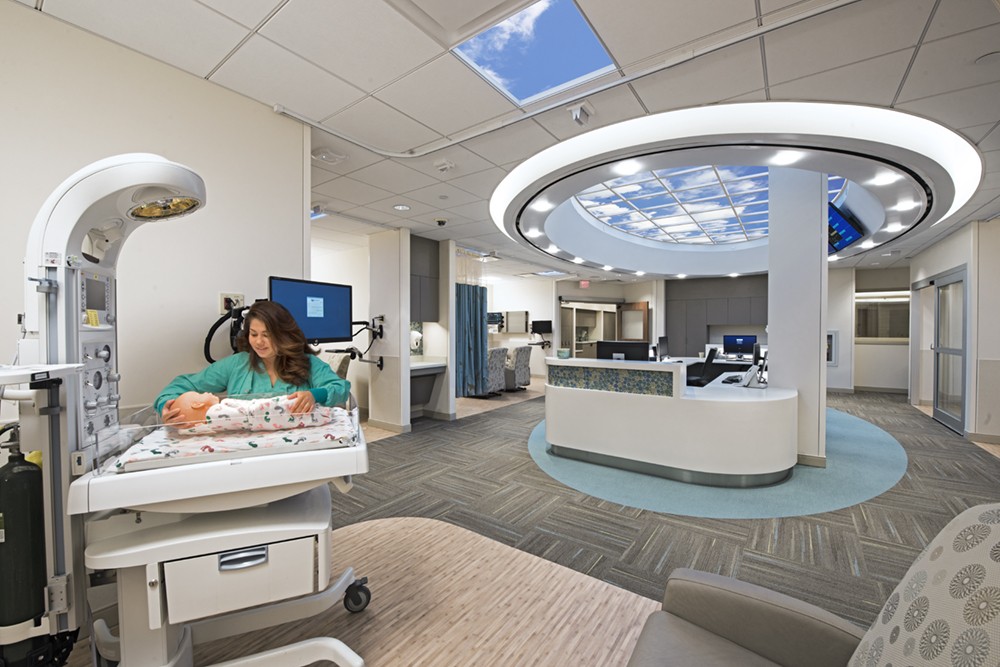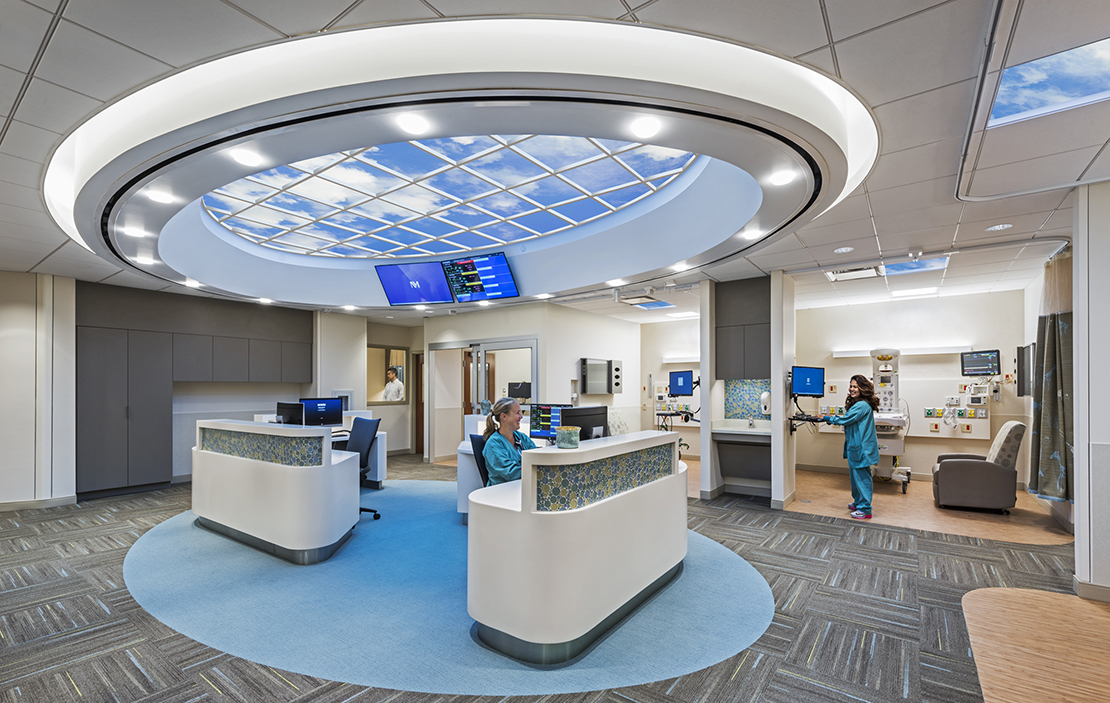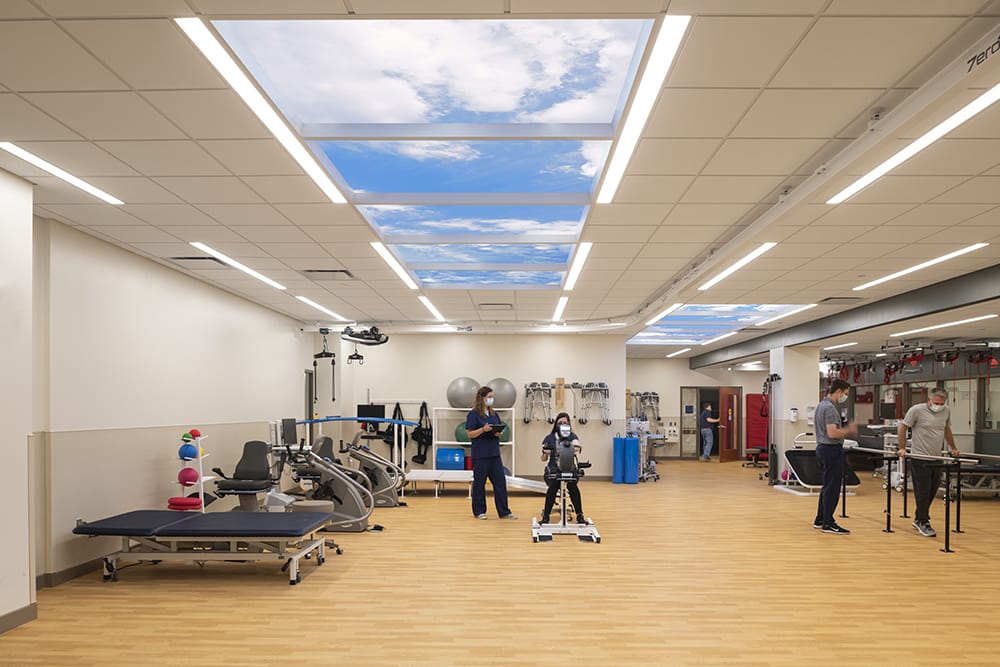The Special Care Nursery at Northwestern Medicine Delnor Hospital in Geneva, IL, is a great case study that reveals the central role biophilic design plays in providing emotional resilience during the healing process. When uncertainty is high and stress is constant, it is imperative that the environment of care itself turns out to be a good source of relief.
The NewLife Maternity Center at Delnor features a 10’ X 20’ elliptical virtual skylight. This custom Luminous SkyCeiling features a curving perimeter that embraces shift nurses, doctors, and all the new parents as they shuttle throughout the day from the seven special care infant bays back to the central hub.
Designed by LEGAT Architects as a therapeutic illusion of nature, the skylight generates relaxing biophilic engagement for all the occupants. The skylight’s calibrated and emotionally nourishing daylight-quality artificial light filters softly from a large format, photographic Open Sky Composition that transforms the nurse station.
Staff benefit from the pervasive experience of perceived open space throughout their shift as the visceral sense of relief we experience outdoors, under a blue sky, is noticeable, even in the isolated confines of this neonatal environment.
The new nursery offers parents and siblings a comfortable place to spend time with premature infants and term infants with medical complications. The 3,100-square-foot makeover brings the spaces up to code, improves workflow, and creates a welcoming ambiance with a soothing color palette and soft lighting.
Healthcare remains one of the most exhausting and demanding service industries, now exacerbated further by the SARS-Cov2 pandemic. Not only do nurses, doctors, and staff have to deal with people in distress, but they also navigate a complex system of competing priorities––medical, corporate, and governmental.

The environment of care where healthcare staff spends long shifts becomes a central element in the battle against burnout. Burnout, broadly speaking, is a combination of exhaustion, detachment, and sub-par performance resulting from chronic job stress.
With an aging population and a high demand for skilled medical staff, a premium exists to retain experienced labor. Studies have revealed a direct link between nurse well-being and higher patient satisfaction, which means that direct investments in healthcare staff wellness result in higher patient satisfaction and delivery of care.
The most beneficial biophilic design interventions are located where medical staff spend the majority of their time: with their patients and patient families.
Illusory Skies and Staff Wellness
By taking advantage of humankind’s ingrained habits of perception, it is possible to work within the confining dimensions of many emergency healthcare settings and introduce a measure of quantifiable, restorative open space, even by means of illusion.
Searching for new visual technologies, particularly those few that incorporate the architectural context of the space, is essential to glean true environmental and therapeutic benefits. While oftentimes visual and other sensory content is recommended to wind down tensions, stimuli intended to offer positive distraction mostly takes place in break rooms or similar spaces that are removed from the workspace.
The most beneficial biophilic design interventions are located where medical staff spend the majority of their time: with their patients and patient families.
The idea is to redress the workspace itself, so that rather than having to limit the therapeutic impact of the wellness break, the environment of care itself can act as a therapeutic feature throughout the day.
Protecting Staff from Burnout
Multiple studies dating back a decade indicate that burnout rates for medical staff like doctors and nurses remain disturbingly high. On average, 1 of every 2 doctors exhibit the classic symptoms of workplace burnout while the same conditions affect 1 out of every 3 nurses.1, 2 Yet another study published in Archives of Internal Medicine (2012), noted that healthcare staff experienced nearly double the burnout rate plaguing American workers in other professions.3
Furthermore, the Covid-19 pandemic has shown how much pressure full-time medical staff shoulder when the healthcare system, across the board, is pushed to the limit. In these conditions, the environment of care has resurfaced as a vulnerable point that could be better equipped to help healthcare staff cope with chronic workplace stress.
The demanding and often isolated nature of many patient care spaces results in claustrophobic and crowded environments. Healthcare interiors often lack the most salient biophilic design features that help restore focused attention or regain a measure of emotional balance through the 12-hour shifts demanded in major hospitals.
The restrictive nature of healthcare codes and the high cost of construction are the main drivers behind highly artificial and technology-laden spaces.
Inquire how you can safeguard your hospital’s staff today.



